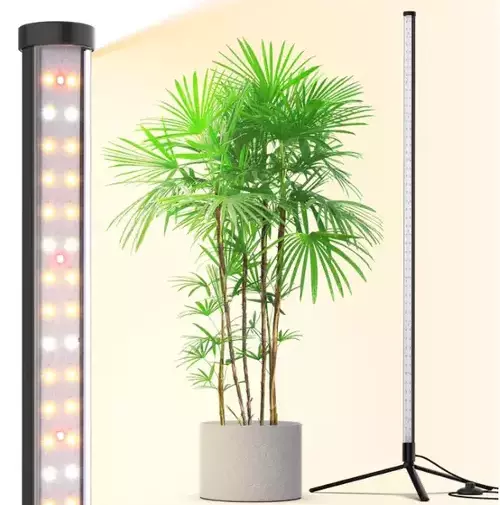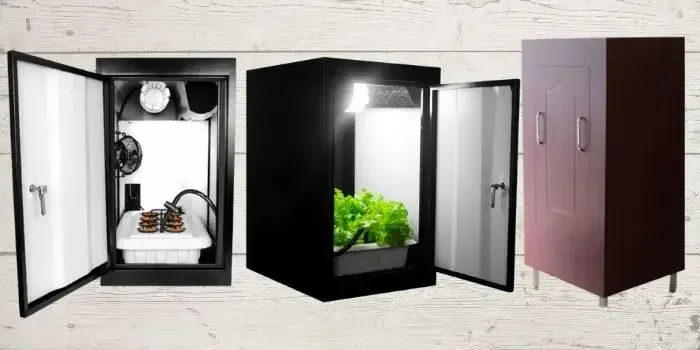Do you fancy adding a splash of colour to your place? Plant hobbyists undoubtedly adorn philodendron Lemon lime for its vivid shades and aesthetic looks. Lemon Lime Philodendron is recognized with various names such as Lemon lime heartleaf Philodendron and Neon Philodendron due to its foliage exhibiting shades of bright yellow to chartreuse colours. Whether displayed on a tabletop or desk or cascading in a hanging basket, it would grab one’s attention with its remarkable neon-coloured leaves. It’s worth mentioning that caring for the Lemon Lime plant is just a piece of cake as it is one of the hardy Philodendrons that doesn’t die easily and is not demanding at all.
Philodendron Hederaceum ‘Lemon Lime’ is a very rewarding houseplant for both beginners and seasonal plant parents with minimal care! Therefore, we have gathered the best growing tips and common problems that Lemon Lime may encounter for optimum care.
Closely-Related Allied Species: Philodendron Brandtianum, Philodendron Moonlight, Philodendron White Knight, Philodendron White Princess, Philodendron Florida Ghost, Philodendron Verrucosum, Philodendron Spiritus Sancti.
Related Products:
Origin and Family
| Botanical Name: | Philodendron Hederaceum ‘Lemon Lime’ |
| Family Name: | Araceae |
| Other names: | Neon Philodendron, Philo Lemon Lime, Philodendron Cordatum Lemon Lime |
| Plant Type: | Cascading & Climbing perennial |
| Origin: | Central and South American |
| Color: | Neon |
| Leaf Shape | Heart-shaped leaves |
| Height: | 6 to 15 feet -Vining plant |
| Humidity: | 40% and above |
| Temperature: | 65°F to 80°F (18°C to 27°C) |
| Light Need | Medium to bright indirect light |
| Propagation | Stem cutting & Air-layering |
| Preferred pH | 6.4 to 7.3 (mildly acidic to neutral) |
| Soil type | Well-drained organic soil |
| Hardiness Zone | 9 to 11 |
| Pests | Mealybugs and Scale insects. |
What Is A Lemon Lime Philodendron?
The Lemon Lime Philodendron is a tropical plant that belongs to the Philodendron genus of the Araceae family indigenous to the rainforests of Central and South America. Interestingly you will find Lemon Lime Philodendron of two types -Philodendron Hederaceum “Lemon Lime.” and Philodendron Domesticum “Lemon Lime.” Both Lemon Lime plants exhibit stunning bright chartreuse leaves, but Philodendron Hederaceum is famous for its trailing foliage, whereas Philodendron Domesticum Lemon lime is renowned as a climbing plant.
Let’s learn the difference between both Lemon Lime Philodendron, and we would like to share an interesting renowned legend of the discovery of the Philodendron Lemon lime plants.
Philodendron Hederaceum ‘Lemon Lime’
Philodendron Hederaceum Lemon Lime is a perpetual plant featuring cascading heart-shaped leaves in various bright colours ranging from brilliant yellow to lime.
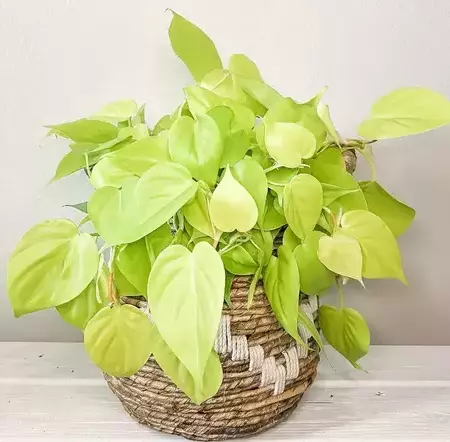
The legend goes that the famous Captain William Bligh- Commanding Lieutenant of the HMS Bounty, acquiring breadfruit plants from Tahiti, allegedly discovered the Lemon Lime philodendron in the 18th century. After the Mutiny on the Bounty, he made it to the Caribbean in 1793 and brought Breadfruit plants there.
The legend goes that he was so fascinated by this stunning Lemon Lime Philodendron during his voyage that he took it to England, where it was cultivated and started its journey as a popular houseplant. Later, the stem cuttings were exported to Florida, where the cultivation began on a larger scale.
Philodendron Hederaceum Lemon Lime is a bright cultivar of the classic Heartleaf Philodendron boasting a greenish-yellow and chartreuse foliage. New emerging leaves exhibit electric pinkish yellow, turning to a deep lemon and finally to lime green ( Neon) as they mature.
Lemon lime heartleaf Philodendron is a prolific grower, producing long cascading vines trailing from hanging baskets, touching the floor or climbing a moss pole, pillars and walls. Hederaceum Lemon Lime can easily be confused with Neon Pothos due to highly similar foliage.
Philodendron Domesticum Lemon Lime
This cultivar of Lemon Lime features long golden yellow-green or lime-green spade-shaped foliage and is also known as Malay Gold or Golden Goddess Philodendron.

Unlike its counterpart, this lemon lime plant exhibits a single stem- a self-heading plant that might need support to climb onto something as it is an epiphytic philodendron. As the Domesticum Lemon Lime grows taller, the thin stem couldn’t keep the plant upright and descend downward. Therefore, mounting this lemon lime with a support stick or moss pole would prevent toppling of the plant.
Benefits of Philodendron Lemon Lime
Philodendron lemon lime is not only a decorative houseplant that accelerates the personification and exterior of your home but it also improves your mental health by reducing anxiety and stress. Other than this, it’s an outstanding plant to purify the atmosphere at the home as it removes toxins from the air and makes it clean and uncontaminated.
How do you care for a Lemon Lime Philodendron?
The Philodendron Hederaceum ‘Lemon Lime’ is relatively straightforward to care for vining plant that can be grown outdoors but is typically grown as an indoor ornamental Plant.
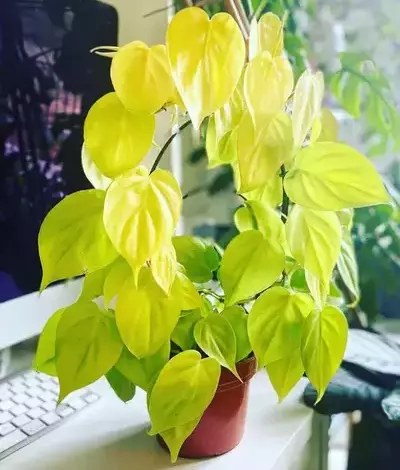
Lemon Lime requires medium to bright indirect sunlight, 65°F to 80°F temperature, 40-50% humidity, and well-draining, good potting soil. In addition, water this plant consistently, letting the soil dry out between watering and fertilizing it occasionally.
Lemon Lime Philodendrons are one of the few houseplants that will not give up on you, and that is precisely the reason for their immense popularity.

Philodendron Lemon lime Growth and Size
Philodendron Hederaceum ‘Lemon Lime’ is a fast-growing and one of the most popular and distinctive types of Philodendron. The plant grows beautiful and bright heart-shaped chartreuse foliage contrasting brownish-green venation on the green stems that trail gracefully. Lemon Lime vines can grow several feet long, 8 to 15 feet tall when climbing. However, the Lemon Lime Philodendron can grow even longer outdoors in more open spaces.
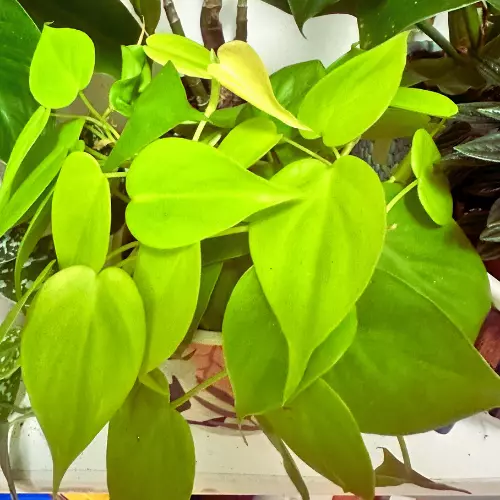
The growth of this heart-shaped Lemon Lime is similar to the Money plant, and when grown in hanging baskets, the vine gently cascades to the ground. The leaves are relatively thin, and new growth exhibits pinkish-yellow color and turns more neon or lime green when it matures.
Is Neon Philodendron a Climber?
Philodendron Lemon Lime is a fast-growing climbing plant that has a vine-like growth habit. The yellow and neon green foliage has a climbing capacity and it can grow fast with long hanging vines and can double in size within a year. The lemon-lime has more leaves per stem than other philodendrons, thus giving it a compact and full appearance.
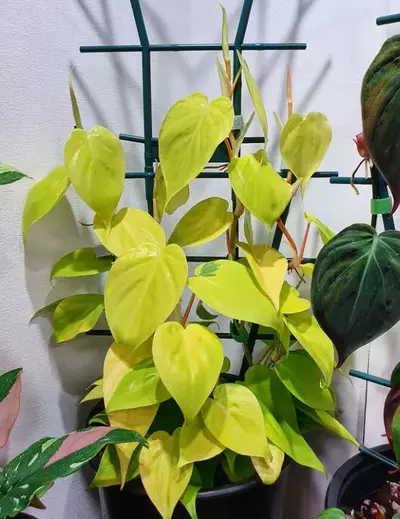
If you are not growing it as a trailing plant, then the sphagnum moss pole is perfect for giving it enough support and encouraging its upward growth. The plant grows aerial roots that cling to something to climb and absorb nutrients. Therefore, providing a moss pole to Philodendron Lemon Lime would help the plant grow bigger leaves as the aerial roots can absorb moisture and nutrients from the moss pole.Remember to keep the moss pole moist.

Temperature and Humidity
Philodendron Lemon Lime is not overly demanding in terms of humidity, and humidity levels up to 40% to 60% are sufficient for it. Believe it or not, it can do pretty well in average household humidity and doesn’t frustrate you with crispy edges. However, you can increase the humidity levels if you want more lush and compact foliage.
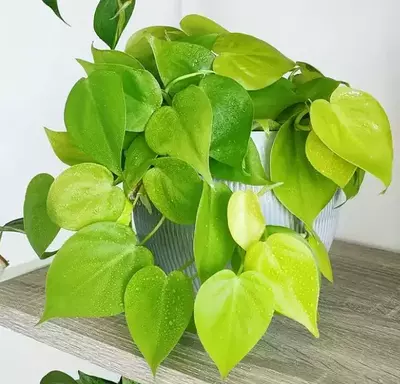
The best and recommended methods for increasing the moisture level in plants’ surroundings are as follows;
- Mist your plant regularly, ensuring an airflow to dry the water droplets; else can result in bacterial leaf spots.
- Use a plant humidifier near your plants.
- Place your tropical plants together to increase the humidity level around the plants due to transpiration.
- Use a pebble tray half filled with water and place the pot on top.
- Place your plant in the bathroom or kitchen where it is more humid.
Temperature
Coming to the temperature, this plant loves warm environments with a temperature range between 65F to 80F. The plant can withstand a few degree variations from its optimal temperature range. But can’t tolerate temperatures below 55°F, leading to stunted growth.
Therefore, keep this plant in a warm spot in your home, especially in winter, to avoid drafts and sudden temperature fluctuations. Also, please keep it away from heaters and Ac vents; otherwise, the plant may wilt. The Lemon Lime can enjoy breezy temperatures outdoors in summer but bring it indoors in winter as the frigid environment is more detrimental to the Lemon Lime plant than the hotter temperatures.
If you notice that your Lemon Lime Philodendron has not sprung new shoots or leaves in months, it is most likely your plant is in a spot that is too chilly. You can use mulch, straw or dried grass for chilly places to cover the soil beneath the plant. It will act as insulation, preventing the heat from escaping to prevent stunted growth. Moreover, you can bring the plant inside during winter and use heating pads and frost blankets to maintain the optimal temperature.

How often do you water Lemon Lime philodendron?
When it comes to watering, the Philodendron lemon lime is not very demanding, but being native to rainforests, this plant needs consistently moist soil for its healthy and fast growth. The plant is thirstier in the spring and summer seasons and usually needs to be watered once a week, while in winter, the watering frequency reduces greatly, and once a month, watering is sufficient for its development.
However, keep in mind there is no set routine for watering frequency; it depends on several factors such as soil mixture, pot type, light, and temperature. Always check the soil moisture before watering your plant.
The lemon-lime prefers almost the top half of the soil to dry before watering. If your plant has yellow leaves that are more vibrant and intense than the regular yellow color, it means you are overwatering the plant. Similarly, if the leaves are brown and crispy, it indicates underwatering. An extended period of droughts also causes dying off leaves and stunted plant growth.
Therefore, always keep balance while watering the philodendron Lemon-Lime and the best method to determine the plant’s water needs is to let its topsoil completely dry. You can use a moisture meter or moisture sensor to check the dryness or use your fingers to examine soil desiccation. Then water it thoroughly, and wait until the excess water drains out from the drainage holes to prevent any root rot or fungal disease.
Bottom watering Philodendrons has been proven successful in my experience. You can simply place your plant pot with drainage holes in a dish or tub filled with water and let the roots absorb water. Leave your plant for 30 to 40 minutes and then take it out and let the bottom of your pot dry.

How much sun does a Lemon Lime philodendron need?
Like most tropical plants, Philodendron Lemon Lime thrives in bright indirect light; therefore, we recommend keeping your plant in an east or North facing window or door where it can get morning or evening low-intensity sunlight.
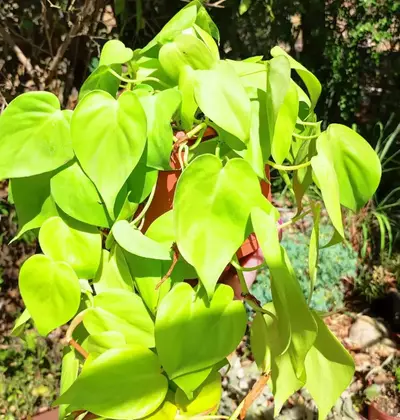
This plant cannot tolerate direct sunlight; therefore, when grown outdoors, plant it somewhere with either dappled sunlight or morning sunlight only, or place it on a patio where it receives adequate indirect and bright light.
Although the Lemon-Lime plant can survive in low light conditions, its growth will be slow, and leaves may lose color and freshness.
However, exposure to bright indirect light encourages the plant to grow faster, bushier, and with large leaves.
Remember, Philodendron Lemon Lime cannot endure direct sunlight as it may damage the plant such as;
- Exposing leaves to high-intensity sunlight may burn the beautiful foliage.
- Brown spots on the leaves.
- Leaves may turn yellow or brown.
- Plant Leaves will droop.
Similarly, lack of light may result in a leggy plant with smaller leaves and longer internodes. Moreover, less light means the plant will not photosynthesize effectively and won’t absorb the complete water from the soil, and it will need less watering.
We recommend placing your plant in a shady spot with indirect sunlight, such as a window sill or a shelf near a window.
If you don’t have a bright spot at your place, using grow lights helps achieve the required light.

Soil Requirement
Philodendron Lemon Lime is not finicky about the soil; any airy, well-draining, and moist medium would help this plant thrive. This type of soil has nutrient absorption ability and keeps the roots moist.
The Lemon Lime plant doesn’t like to sit in damp soil as it can cause root rot. Regular potting mix is a too-dense growing medium as it doesn’t let oxygen flow to the roots and causes poor drainage resulting in fungal problems.
Lemon Lime prefers loose and organic-rich soil to thrive best. I usually add chunky components to my soil mix to permit more air to the roots and drain excess water, thus preventing root rot and other diseases.
Here is my recipe to prepare an evenly moist substrate by mixing the following ingredients;
Besides that, if you don\t want the hassle, you can also choose from our recommended potting mixes available in the market, such as:

Fertilizing
Like all other indoor plants, the Philodendron Lemon Lime also likes to be fertilized, especially in the growing season, as it needs more nutrients during growth. Therefore, using a mild fertilizer in the growing season will help to boost the plant’s performance and development. But remember that the pant doesn’t need much feed in winter, and fertilizing it once in two months is sufficient for its growth.
The philodendron plants love all-purpose liquid fertilizers diluted to half strength. Moreover, some plant parents prefer granular slow-release fertilizer as it is also very effective for its growth and reduce the chances of foliage and root burn. Whatever feed you use for your lovely plant, ensure not to over-fertilize it, or else chemicals will burn the plant.
Here are some good fertilizers for your Lemon Lime available on the market:

Potting
Philodendrons prefer a well-draining pot to drain the excess water to prevent root rot and through which oxygen can flow to the roots. You can plant your Philodendron Lemon Lime in a plastic, terracotta, or ceramic pot that is permeable and with suitable drainage holes. You can also choose self-watering plastic or ceramic pots for plants prone to root rot. I usually prefer plastic pots with bottom drainage side holes and then placing that in a decorative pot.
Remember to choose the pot size depending on the root ball size. A large pot may not let the soil dry and may suffocate the roots resulting in fungal and root problems.

Repotting
As philodendron lemon lime is a fast grower, that may need frequent repotting, probably once or twice a year. The rule of thumb is when your plant is root bound, repot your Lemon Lime in a pot one or two sizes larger or two inches (five centimeters) wider.
Typical signs of root bounds are;
- Roots peeking through the drainage holes.
- Roots start to whirl up around the pot wall.
- The plant stops growing.
- The soil dries frequently.
The active growing season is the best time for transplanting as the plant is vigorous and reduces the risk of shock.
Here is a step-by-step guide to repot your Philodendron Lemon Lime ;

Philodendron Lemon Lime Propagation
Since Philodendron Lemon Lime is a trailing plant with aerial roots and multiple growth points or nodes, it can easily be propagated via stem cuttings and air layering with 99% success rate. Neon Philodendrons cannot be propagated through seeds since these plants rarely bloom.
Stem Cutting Propagation
Lemon Lime Philo. can grow unruly and need regular pruning. Therefore, you will get stem cuttings for propagation. Philodendron Lemon Lime doesn’t go dormant, so you can attempt to propagate any time of the year.
Follow a step-by-step guide to propagating Neon Philodendrons via stem cutting.
Air Layering
Philodendron Lemon Lime grows aerial roots along its stem and can be propagated using air layering method. However, this is less common method compared to stem cutting propagation method.

Pruning and Maintenance
As philodendron lemon lime is a fast grower, regular Pruning after three to four months is necessary for its growth, especially in the growing season. The Pruning encourages healthy growth by producing new leaves. You can also trim the stems to boost the thicker look of the plant. Slightly trim the stem above the nodes to stimulate new growth. Moreover, you can propagate the cuttings and replant them in the pot to make the plant bushier.
Clipping old and damaged leaves is also necessary to prevent the plant from diseases and infections. Regular plant maintenance is a great way to improve its health and appearance.
Never forget, always use gloves and disinfected shears and scissors for Pruning.
Moreover, cleaning the foliage with a damp cloth helps prevent pores from clogging and helps plant photosynthesize better.

Is philodendron Lemon Lime toxic?
Like all Aroids, this plant is poisonous to humans and pets as it contains calcium oxalate crystals in its cells. It is hazardous to cats, dogs, and humans, and any ingestion can cause a swollen tongue, stomach ache, trouble breathing and skin irritations. Moreover, it can cause swelling in the mouth and throat, and vomiting. In case of these symptoms, please seek medical assistance.

Lemon Lime Philo. Diseases & Pests
Although philodendron lemon lime is an easy-to-grow plant but is still susceptible to some problems.
Common Problems
Some common issues you may face with this plant are explained below to make you wary about your plant’s condition.
Yellow leaves:
Even though it’s hard to tell if your plant has yellow leaves as its natural color is also kind of yellowish and very light, however, if you notice the leaves are less green than usual, it’s a sign of overwatering.
To quickly solve this issue, check the soil moisture; if the soil is soggy wet, gently uproot the plant and remove the wet soil and repot your plant in a pot with fresh potting mix. Don’t water the plant until the leaves droop a little and the top two inches of the soil feel dry. When you water your plant, make sure to drench the soil and let the excess water drains through the drainage holes.
Curling leaves:
When you notice that your Philodendron lemon-lime has curling leaves, it indicates underwatering. It will help if you regulate the watering schedule and frequency to tackle this problem.
The quick fix for this issue is watering the plant thoroughly and letting the excess water drain off the drainage holes. After that, continue your regular and balanced watering frequency.
Drooping leaves:
The leaf drooping signifies that your plant isn’t receiving enough light. Along with insufficient light, other significant causes of drooping leaves are lack of nutrients and pest attacks such as mealybugs. After noticing the problem, identify the cause and resolve it accordingly.
Pests and Diseases
Philodendron lemon lime is not prone to pests and diseases, and interestingly, it can go through without any pest problems and disease in its entire life span, but it’s only possible if the plant is healthy. Therefore, you need to be aware of common pests and diseases that this plant may have to keep it healthy and thriving.
Pests
The weak and stressed lemon lime plant is more prone to pests. The most common pests that might attack your plant are mealybugs and spider mites. These small insects usually grow on the leaves and stems of the plant and damage it by sucking the sap from the philodendron, which results in a lack of nutrients that are required for the plant’s growth, further making it more stressed and weak.
In case of infestation, shower your plant leaves and treat the leaves with a solution of one part isopropyl alcohol and four parts water. Continue spraying the leaves once a week for at least four weeks.
Moreover, in case of spider mites and mealybugs attack, you can treat them with insecticidal soap or Neem oil spray.
Diseases
Lemon-Lime plant is usually tolerant to diseases, but many encounter a few problems.
Root rot:
It’s the most common disease that your plant may have. The symptoms of this disease are yellowing of leaves, and the significant cause of root rot is excessive moisture; when the water doesn’t drain out from the soil, it results in excess moisture in the soil leading to root rot.
This disease prevention is straightforward; you only have to look after the watering frequency and not let your plant be overwatered. If you notice symptoms of root rot such as yellowing of leaves, gently remove the plant from its pot and inspect the roots. In case of any brown or black roots trim them using a sterilized scissors. Moreover, repot the plant using some fresh well-draining potting mix.
Also, place the lemon-lime in an airy, warm and bright space where it can photosynthesize efficiently to absorb all the water from the soil.
Leaf spot:
The leaf spot disease can be caused by fungus and bacteria that are introduced to your plant from the outside. The signs of leaf spots are brown spots and yellow halo on the leaves.
You can prune the majorly infected leaves and treat the plant with some antifungal spray. Maintaining the moisture conditions and using fungicides to treat the issue is essential to prevent this disease.

Common Queries
Can I grow Philodendron Lemon Lime in water?
Yes, you can grow philodendron lemon-lime in water, take a stem cutting with the help of sharp scissors and place them into water. Please include two or three leaves and a node in the cutting for successful rooting. Once the stem cutting begins to grow roots, you can transfer the stem cutting to the moist soil.
Is the golden goddess philodendron the same as the lemon-lime Philodendron?
Golden Goddess Philodendron and Lemon-lime Philodendron are the same plants, sometimes called Malay gold as well. These are all the names of vividly shaded and aesthetically appealing, heart-shaped chartreuse foliaged Philodendron plant- the Philodendron Hederaceum’ Lemon Lime‘.
Can Philodendrons survive without sunlight?
All species of Philodendron need bright and indirect light. They can also do well in partial shade, but it’s almost impossible for these amazing plants to survive without sunlight. If you notice leggy stems with long gaps between leaves, it’s a symptom that your plant is deprived of sufficient light and needs to be relocated.
Why is my Lemon Lime Philodendron losing leaves?
Leaf loss can happen for various reasons, such as hot or cold drafts, low humidity, pest attack, and lack of light. If your lovely Philodendron is facing any such issue and losing its leaves, treat your plant accordingly to let it grow and thrive.
Are Lemon Lime and neon philodendron the same?
Neon Philodendron or Philodendron Cordatum Neon is an evergreen vining and cascading houseplant featuring vivid neon hues, from golden lime to emerald green heart-shaped leaves. Lemon Lime Philodendron has two variants; one is cascading- the Philodendron Cordatum and the other Lemon lime variant features long spade-shaped foliage in shades of bright yellow to chartreuse and has a climbing nature.
Are Philodendrons high maintenance?
The philodendrons are not very fussy plants and don’t encounter pests’ problems quite often, making them great indoor houseplants. If you are a beginner and want to collect low-maintenance and easy-growing plants, the philodendrons are the best options.

Conclusion
Philodendron lemon lime is an easy to grow houseplant with stunning in bright yellow and chartreuse shades. It cascades beautifully to elaborates shelves and windows with neon and green vines. The lemon lime is not only visually appealing but it also improves the air quality by removing the toxins from the atmosphere.
Due to its easy maintenance and growth, it’s a perfect plant for offices, schools, shopping centers and homes. This is a perfect plant for you if you want to have a clean and aesthetically elegant environment.
So, what are you waiting for, grab this beauty and lit your home with its exquisiteness.
Related Posts
Best Grow Box for Beginners – (Stealth Box & Grow Cabinet)
The best grow box for beginners shall be super easy to set up and operate, requiring minimum intervention and fulfilling your preferences of stealth and decor. We have tested and reviewed top-of-the-line models available in the market and will provide…
Best Humidifier for Plants & Homes
We have tested and reviewed the best humidifier for plants from performance, maintenance, and functional aspects suiting your home needs.
Maranta Arrowroot Care Guide
A detailed care guide for Maranta Arundinacea also known as Maranta Arrowroot, is known for artistic-looking foliage and beneficial roots.
Maranta Lemon Lime Care Guide
Maranta Lemon Lime with optimum care, displays beautiful textured, velvety look foliage with different shades of green.
Maranta Leuconeura Prayer Plant Care Guide
Maranta Leuconeura commonly known as Prayer plant due to its distinctive postures during day and night, requires little care to flourish.



